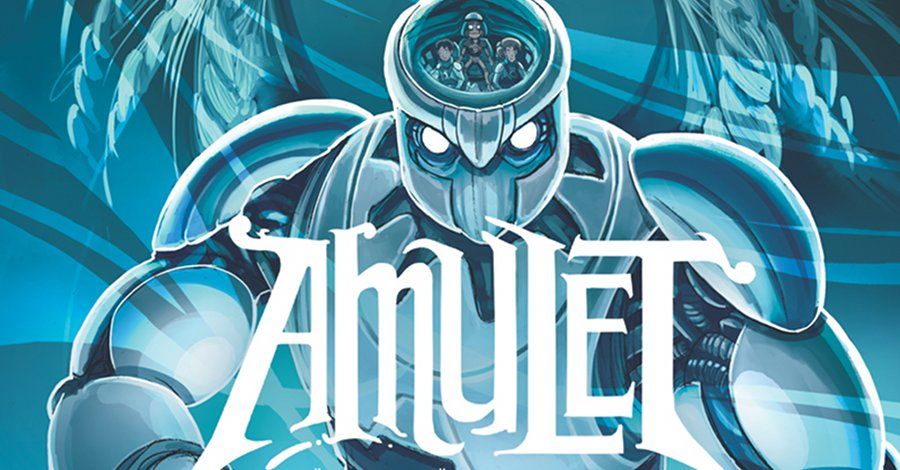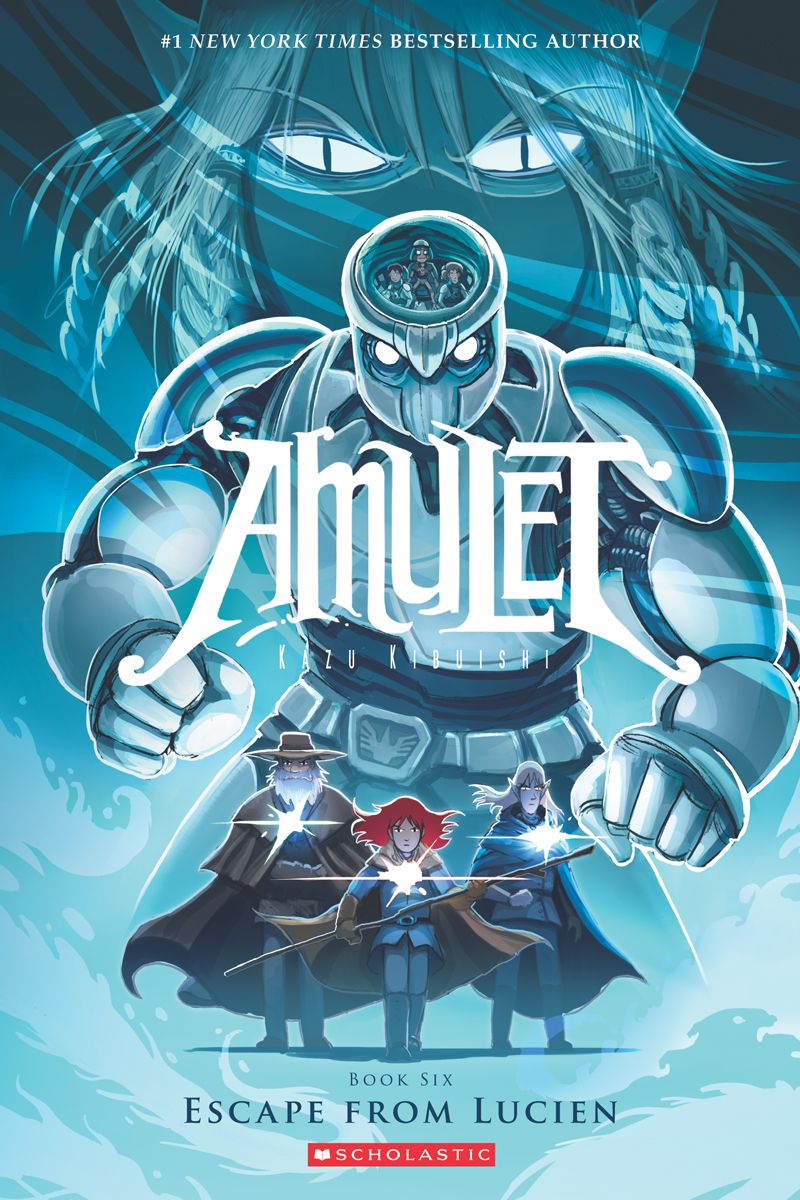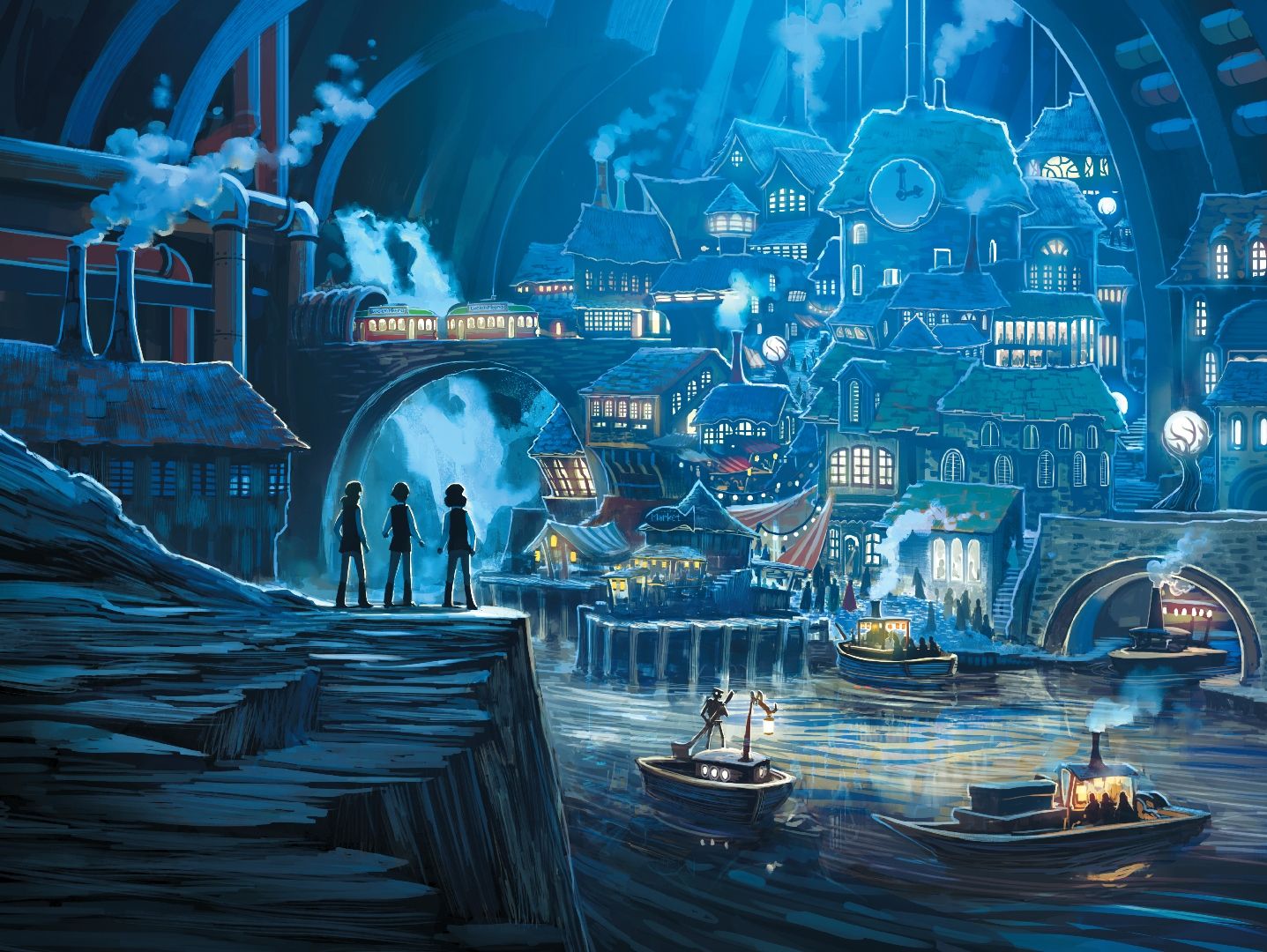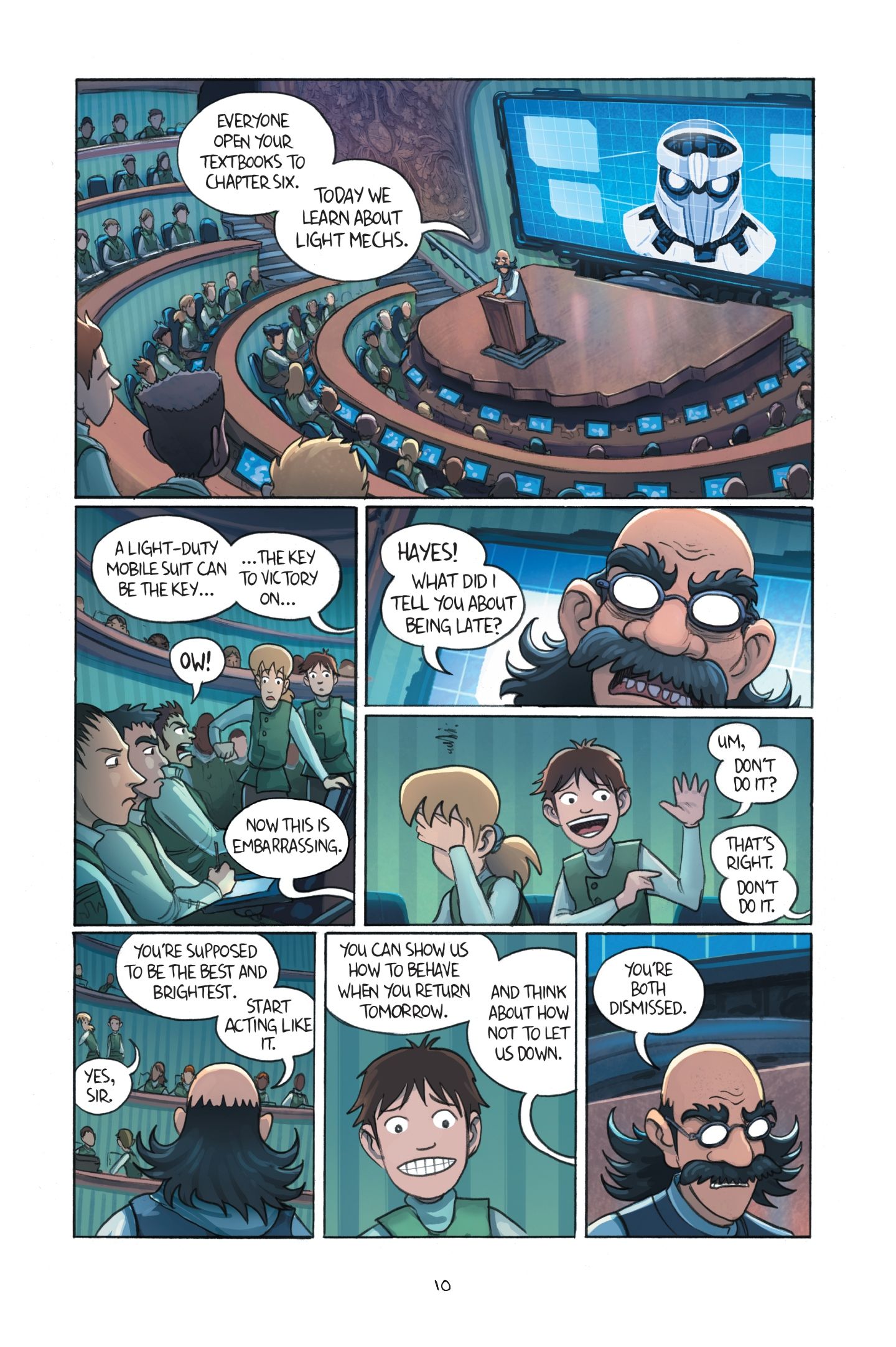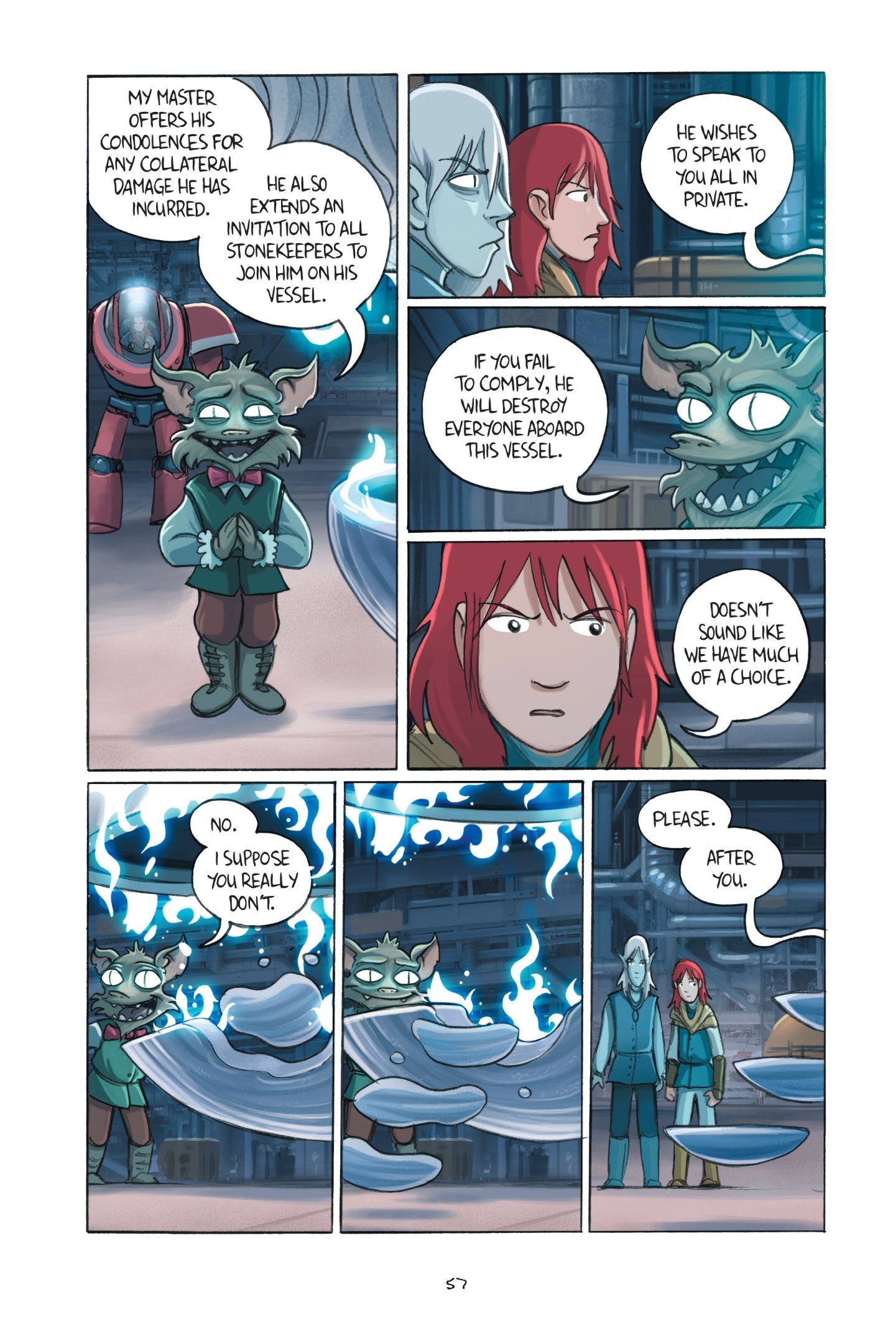Kazu Kibuishi has long been a busy creator. The longtime editor and founder of the acclaimed "Flight" anthologies, he currently edits its spiritual successor, the all-ages "Explorer" anthology series. When he's not doing freelance illustrator jobs (like new covers for the re-release of the "Harry Potter" series of novels) Kibuishi is also writing and drawing his own comics like "Copper," "Daisy Kutter: The Last Train" and the ongoing, all-ages "Amulet" series.
The series focuses on the brother/sister duo of Emily and Navin, who thanks to a strange amulet have discovered a parallel earth full of warring citeis, elves and steampunk-esque technology.
Out this month is "Amulet: Escape From Lucien," the sixth volume in the series published by Scholastic's Graphix imprint. Kibuishi spoke with CBR News about the years-long struggle to get the series right, his love of classic "Final Fantasy" games and what fans can expect from the underground city at the heart of the new volume.
CBR News: For people who have forgotten where are we when "Amulet: Book 6, Escape from Lucien" opens?
Kazu Kibuishi: The introductory scene features Max and the Elf King, but that's more like a prologue. When the story really begins, we're in the air above Lucien, a ruined city. Our heroes are on board an airship en route to fight the Elf King, where they are training to pilot the giant robots in the Colossus program. Emily, Trellis, and Vigo are also on board, discussing their plan of attack.
The story, like the rest of the series, essentially follows two threads: Navin journeys through a very physical battle above and below ground, and deals with the issues of the more common townsfolk. Emily operates in the more overarching governmental structures of this world. While Navin's actions affect people in a very direct manner, Emily's actions affect everyone in this world in a less direct manner.
What is Lucien?
In the previous books we were introduced to the city of Cielis floating in the sky. Lucien is Cielis's neighboring sister city. While the people of Cielis floated into the clouds to avoid conflict, the city of Lucien buried itself underground. In this book, our heroes will need to journey underground and -- as implied in the title -- escape it!
The book features the return of some familiar characters and also some new characters like Riva. Who are these new characters?
Riva is the mayor of Lucien. She's an elf who inherited her father's underground caverns, and the people of Lucien began there to avoid invading creatures. She came to prominence as their chosen leader. Her second-in-command is a robot named General Pil who has quickly become one of my favorite characters to write, and there is a young man named Patrick -- the leader of a group of rebellious kids -- that plays a big role in this book. The heroes of Lucien really embody the kind of people I like best: hardworking and honest people who try to make the best of a given situation. We also meet a couple of other students in the Colossus program, Robert and Trisha, young students who play a pretty big role in this book.
Do you have a favorite moment or scene from this book with General Pil?
I love seeing General Pil with his parents. I also love his hometown. My assistant and I have a shared love of the older "Final Fantasy" games so we both enjoyed working on that scene.
How has the project changed for you over the years. You've said that initially "Amulet" was one book. How has it changed for you as you've been working on them?
When I began working on the book in college, the idea was that it was an epic tale with no real ending in sight. It was exhausting to even think about tackling a project like that, and after many false starts I shelved it for years. When I worked in animation, I began developing it as a single movie's story, scaling down the initial scope of it, and when I began working in comics full-time, the idea was to take that single movie version and make a graphic novel from it. This is when I thought I could do the story as a single 300-page book. Soon the project began taking on an episodic structure to accommodate the growing story, and now we're here, well over a thousand pages with a long ways to go. The complexity of it is something I never planned for, but seeing it come together in this organic way has been really rewarding.
You're balancing different stories taking place in different locations with an increasing cast of characters. How has this juggling process been like? Is this something you're comfortable with by this point?
It's difficult to say I'm totally comfortable with the process, but I have gotten used to it. In some instances, the multiple threads work out great, but most times it can be really frustrating trying to decide who gets more time and attention. Also, comics are really good at compressing information, so by switching places and time periods in quick succession, the story begins to feel bigger, grander, because I'm able to layer in more information in the space we have available.
One aspect of the series that really stands out, especially after reading all of them in a short span of time, is how the books may not stand on their own, but each book does have story arcs. It is a satisfying read, but it's also part of a larger narrative. Has that been a challenge, particularly in the later books?
I really try my best to make each book stand alone because I know people are going to pick up the series at the newest one and then go back to the earlier volumes if they enjoy it. This has definitely been a challenge, but every time I write a book, I try my best to put myself in the reader's shoes, and my job is to write for reluctant readers. Reluctant readers might not just be readers who haven't developed a love of reading or developed their reading skills, but they could also be people who think the books look like something they aren't interested in. If the later books in the series are too confusing as standalone works, then it's hard to get new readers on board.
One of the plot threads in this book involves a few characters traveling into the Void. Did you want to talk a little about what that is and about what you were thinking of when you worked on drawing it and the color scheme?
The Void is a space where stonekeepers can go that is made up of their memories. This is where the Voice operates. It's his home court. The color scheme for the Void in this book was based off the look of old, faded, polaroid photos. It's like the retro filters on people's social media snapshots. I figured the slightly toasted and overexposed look would subconsciously make people feel like they are watching a memory.
You have a great sequence early on as the ships are attacked and they have to figure out how to land the colossus. Could talk a little about putting that sequence together and the challenge of trying to pace an action sequence like that on a comics page?
These are actually the most fun sequences for me as a storyteller, because I only need to worry about being in the moment and pacing everything well. These are things that I love to do. The difficult part is trying to weave in any necessary story information while the action is happening, because these sequences tend to take up more space and the story is decompressing. The harder sequences are the ones where a lot of exposition is involved, where I have very little space to get across a lot of information. When I draw the action sequences, I just thumbnail the whole thing in one sitting, then do it again several times, "rehearsing" it. When I'm ready to pencil, I just take a look at the various thumbnail drafts and pick the best frames and moments to create a final sequence that I commit to ink.
I know you have a new "Explorer" book out this fall. Can you talk a little about what we'll see in "Explorer: The Hidden Doors?"
"Explorer: The Hidden Doors" features stories by Jason Caffoe, Faith Erin Hicks (with colors by Noreen Rana), Steve Hamaker, Jen Wang, Johane Matte (with colors by Mary Cagle), Katie & Steven Shanahan, Doug Holgate & Jen Breach and myself (with colors by Denver Jackson). Like the first two volumes, this one has a theme, "The Hidden Doors," and everyone has come up with a wildly different interpretation of it. I think this collection is the strongest entry in the series so far. I'm looking forward to seeing how people like it, and I'm looking forward to seeing all these talented artists and writers moving ahead with even bigger projects in the future!
So could you tease a little of what we can expect to see in the next "Amulet" book? Our heroes are separated, Emily is intent on taking the fight to the Elf King, the house is on the move, Trellis is stepping up, and Max mentioned a place named Algos Island.
I do have much of the next book already planned out, since so much of what happens in the next book is material that I intended to put in Book 6 but couldn't fit. The book is going to have some pretty major revelations, relating especially to the backstories of our main characters. I don't think I can say any more than that!
I have to ask: You had seven volumes of the series planned. Is book seven the last? Or will there be more "Amulet" to come?
I'm currently focused on making "Amulet 7" the best book I can possibly make. Scholastic and I have already discussed how to continue working together, and we have a plan. I'll let Scholastic handle any announcements on that front!
"Amulet: Book 6, Escape from Lucien" is on sale now from Scholastic's Graphix imprint.

